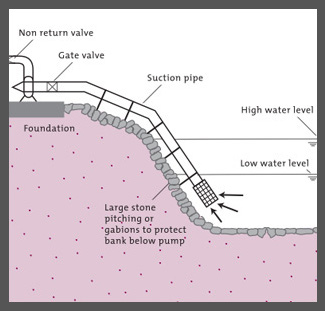Water Portal / Rainwater Harvesting / Surface water / River-bottom intake
River-bottom or Tyrolean intakes for drinking-water systems are usually used in small rivers and streams where the sediment content and bed load transport are low. The water is abstracted through a screen over a canal (usually made of concrete and built into the river bed). The bars of the screen are laid in the direction of the current and sloping downwards, so that coarse material can- not enter. From the canal, water enters a sand trap and then may pass a valve and flow by gravity, or be pumped into the rest of the system.
Intake designs aim to avoid clogging and scouring and to ensure the stability of the structure even under flood conditions. Where the river transports no boulders or rolling stones, an unprotected intake may be adequate.
Contents
Suitable conditions
- Rivers with little sediment and bed load.
- Where there is adequate flow.
- At a level that allows gravity supply to minimise pumping costs.
- Upstream of densely populated and farming areas to reduce silt inflow.
- Upstream of cattle watering places, washing places and sewer outlets (to eliminate pollution of the water).
- Upstream of bridges (to reduce velocity/turbulence).
Construction, operations and maintenance
The bottom of the intake structure should be at least 1m above the riverbed to prevent any boulders or rolling stones from entering. The intake structure must always include one or more baffles or screens to keep out debris and floating matter such as tree trunks and branches. It is advisable to use “passive” screening that does not create turbulent flow conditions. To reduce the drawing in of silt and suspended matter, the velocity of flow through the intake should be low, preferably less than 0.1 m/s. To make use of the natural current to help cleaning of screens, the following tips are suggested:
- The screen axis must be parallel to the current flow
- Dead-end approach channels should be avoided as they collect debris
- Adequate water cover must be provided all around the screen
A river intake always requires a sufficient depth of water in the river. A submerged weir may have to be constructed downstream of the intake to ensure that the necessary depth of water will be available even in dry periods. This type of weir is only a small structure and cannot be expected to provide any storage or flow balancing. Ideally the weir should be founded on rock, to provide the best conditions with regard to bearing capacity, seepage and safety against sliding. Soils with a clay/silt content that reduce permeability and increases cohesion (but with low plasticity) are also acceptable as foundation materials. A key at the upstream toe of the weir will improve stability and an upstream apron will extend the seepage path and thus reduce seepage.
Maintenance
A river-bottom intake is usually operated by a caretaker. The inlet must be checked regularly and obstructing debris removed and any damage repaired. The sand trap must be cleaned regularly. Preventive maintenance consists of painting the screens and other metal parts, such as sluices or valves. Depending on silt and bed load transport, the sand trap and screen will have to be cleaned regularly, and the screen or valve may need repairing. Any erosion undermining the structure must be repaired immediately. Every year, the concrete structure should be checked for cracks and repaired if needed. The water users may be required to help with annual cleaning and major repairs.
Potential problems
- Clogging by silt or debris
- Undermining by river currents
- The river or lake water may be polluted
- During the dry season, there may not be enough water in the river or stream to supply all users.
Costs
Field experiences
Reference manuals, videos, and links
Acknowledgements
- Masanganise, Nhamo. Surface water intake and small dams.

